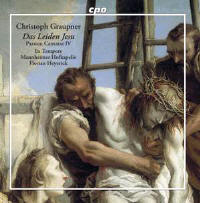Texte paru dans: / Appeared in: |
|
|
Outil de traduction ~ (Très approximatif) |
|
|
Reviewer: Bertil
van Boer As I’ve often said before, Christoph Graupner is the Mr. Cantata of the late Baroque and early Classical eras. Like Georg Philipp Telemann, he began his career at the court in Darmstadt, but unlike his colleague, he remained there for all of his life. Although he occasionally was tempted by other offers, such as the post of cantor at St. Thomas in Leipzig (which he turned down, and it was then given to Johann Sebastian Bach), he had a unique situation there, where he had at his beck and call a fine instrumental ensemble, good voices, and the ability to experiment in terms of his compositional style. Not surprisingly, Graupner was able, like Telemann, to move with the times, and by the end of his long life in 1760 he was firmly implanted in the style we call Empfindsamkeit. Among his duties, he was required to compose Lutheran cantatas throughout his career, eventually composing about 1,500 of them; needless to say, this sort of makes Bach’s number seem paltry in comparison, though this is a quantitative, not qualitative quip. Here, he was fortunate to have in residence Johann Conrad Lichtenberg, a renowned theologian and author, who churned out cantata texts by the dozens. The second piece of luck is that a large number of the collaborative cantatas have survived at the Landesbibliothek in Darmstadt, meaning that they are available for research, editing, and resurrection (ahem) in performance. And increasingly, these have been appearing on CPO in a series of volumes, each devoted to the appropriate church Sunday and season. This fourth volume consists of a lengthy Passion cantata, Das Leiden Jesu, composed as the last in the 1741 Passion cycle. As nothing else conforms to the series here, conductor Florian Heyerick has chosen some 13 chorales taken from the various other Passion cantatas between 1713–1751, a sort of ultra-Lutheran benediction to this set. The chorales have various settings that add musical interest to the hymns. For example, the first, “Hab ich dich in meinem Herzen,” has a rather spare cantus firmus unison around which a violin line weaves. In “Dies ist alles” the chorus has a rather complex contrapuntal exposition that merges at times into a homophonic texture, with contrasts between the voice. “Hoff, o du arme Seele” has the chorus acting as a whole ensemble with a rather straightforward hymn, but the violin accompaniment makes it more of a choral aria (if one can coin a contradictory term). In “Sie wüten fest” the accompaniment is far more agitated, an unsettling underpinning for the chorale tune. Finally, in “Jesus stirbt! Ach! Bittres Sterben” the solo sopranos add a reflective set of suspensions that float lyrically in a most unchorale-like way. The main course is the cantata, like much of Lichtenberg’s work in the numerologically influenced seven movements. Three accompagnatos and two arias are flanked by a Dictum at the beginning setting the tone of the day’s sermon and a final chorale at the end. The former has a fulsome homophonic chorus around which trilling oboes swirl, the mood rather joyous, though not brilliant. The aria “Ach Jesu, was muss du ertragen” is sparse, with a continuo that lightly touches the downbeats, while a lone violin and oboe float about in echo imitation. The tenor seems equally as flighty in his lines, deferring to the instruments as if hesitant to interfere with their duet. The second aria, “Bedenk’s, mein Herz,” has Graupner sustaining the woodwinds in long chords before moving in parallel thirds in a rather jaunty dotted rhythm. The duet of soprano and alto, performed with clear tone by Viola Blache and Franz Vitzthum, adds yet another reflective tone. The cantata is one of Graupner’s most sensitive pieces, with a light-hearted and yet reflective mood, yet clearly in the new emotional style of the time. The Baroque rhythms peak through now and again, but the use of the instruments, particularly the oboes, allow for a careful and texturally adept work to emerge. Of course, the feeling is enhanced by Heyerick’s fine conducting, not to mention the small vocal ensemble Ex Tempore, where the soloists are drawn from the group, augmented in the choral bits only by four others to form a double quartet. This is complemented by the Hofkapelle, here reduced to one on a part, lending the performance a particularly intimate quality. It goes without saying that this disc is a fine conclusion to the Passion cantata series, and the extracted chorales form an extra bonus, noted for their quality and variety of treatment. This is an excellent disc, not only showing Graupner’s ability to turn the most conventional sacred text into a sensitive and reflective work, but also his genius in the composition of the genre.
| |
|
|
|
|
Cliquez l'un ou l'autre
bouton pour découvrir bien d'autres critiques de CD |
|




